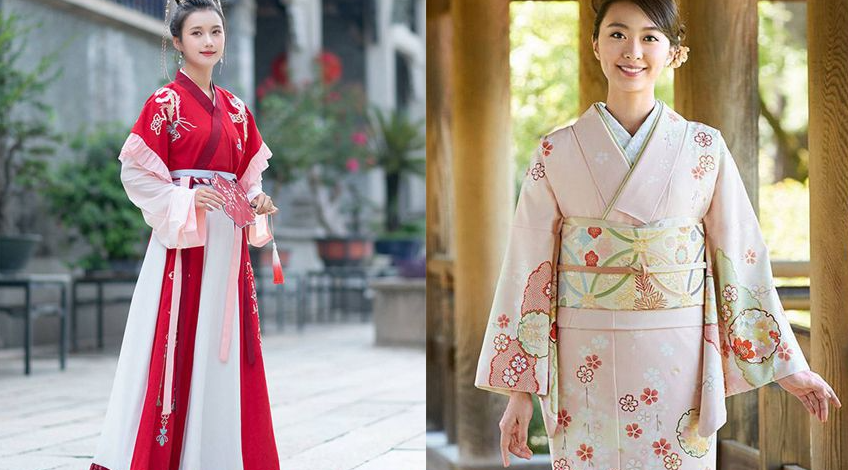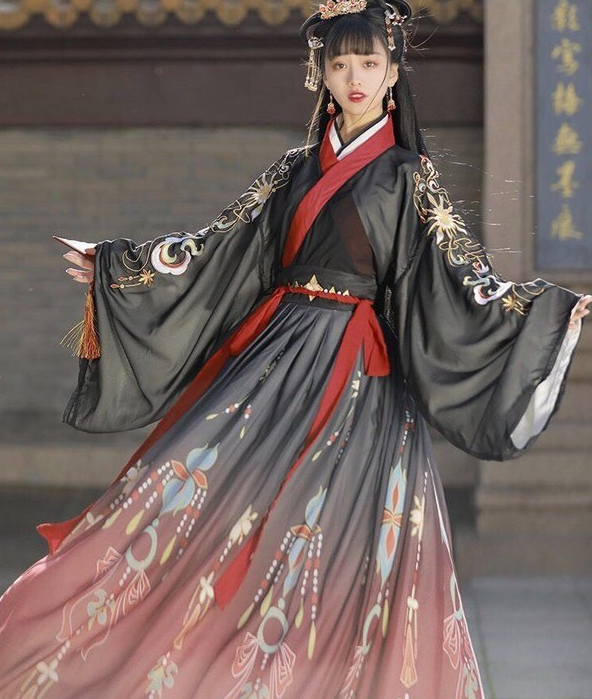Hanfu originated in ancient China, predating the Kimono, which developed later in feudal Japan.
Historical Context
Ancient China and the Origin of Hanfu
The history of Hanfu can be traced back to the Han Dynasty, where it began to take its recognizable form. As a traditional Chinese dress, Hanfu has its roots in various dynasties, with influences seen as far back as the Shang and Zhou periods. Over time, Hanfu has undergone significant transformation, with each dynasty adding unique elements to its design. Several variants such as the Shenyi, Zhiju, and Aoqun were prominent among the Chinese people. Emperor Wu of Han was particularly significant in making Hanfu a symbol of Han Chinese identity.
The fabrics used for Hanfu were often intricately woven silks, showcasing the advanced silk-weaving techniques of ancient China. The colors and motifs also had symbolic meanings; red represented joy, while blue symbolized integrity. The attire was also gender-specific and signified one’s social status, from peasants to the royal family.

Feudal Japan and the Origin of Kimono
While Hanfu had a longer history, Kimono started gaining prominence in Japan around the 8th century, during the Heian period. Unlike Hanfu, Kimono is not tied to one specific ethnic group or period in Japanese history. The design of Kimono was significantly influenced by the Chinese Tang Dynasty fashion, although over time it evolved to reflect uniquely Japanese aesthetics.
Originally, Kimono was known as “kosode,” a term referring to small sleeves, distinguishing it from other clothing styles at the time. The garment was more simplified than Hanfu, focusing on straight lines and the T-shaped cut. The garment’s length and sleeve size often varied based on the wearer’s age, marital status, and occasion.
Cultural Exchange Between China and Japan
Cultural exchange between China and Japan has a long and rich history. As early as the 5th century, Japan sent diplomatic missions to China, known as Kentōshi, to learn from its advanced civilization. Among the things imported were Chinese philosophy, art, and, of course, clothing styles. This led to the adaptation and incorporation of Hanfu elements into early Japanese clothing, which eventually evolved into what we now know as Kimono.
Design and Characteristics
Features of Hanfu
Hanfu is well-known for its elegant and flowing designs, which often represent the philosophies and aesthetics rooted in Confucianism and Daoism. The most traditional forms of Hanfu include garments like Shenyi, Pao, Zhiju, and Aoqun. These styles often consist of a top garment that crosses over the body diagonally and a bottom garment that could be either a full-length skirt or trousers.
The fabrics used in Hanfu typically involve luxurious materials such as silk, linen, and occasionally brocade. Patterns and motifs on these garments usually depict traditional Chinese elements like dragons, phoenixes, and floral designs.
Features of Kimono
Kimono has a more simplified design compared to Hanfu, consisting of straight seams and wide sleeves. Unlike Hanfu, Kimono often uses a belt, known as an Obi, to secure the dress around the waist.
The fabric used in making Kimono can vary greatly, ranging from cotton to intricate silks. Unlike Hanfu, which can have various vibrant colors, Kimono colors often relate to the seasons or the wearer’s age and marital status. Patterns might include natural elements like cherry blossoms, birds, or rivers.
Similarities and Differences
Both Hanfu and Kimono have a rich history and are deeply integrated into their respective cultures, often worn during traditional ceremonies and festivals. While Hanfu generally has more variations in terms of garment types, Kimono is more rigid in its T-shape design but has more flexibility in sleeve and body length.
Cultural Significance
Hanfu in Chinese Culture
In the context of Chinese history and culture, Hanfu is far more than just an item of clothing; it is a cultural symbol with deep roots. Hanfu has been strongly influenced by Confucian ideals, representing virtues such as respect, dignity, and decorum. The style of the Hanfu can even represent one’s social standing, from the ordinary citizen to the scholars and nobility. Traditionally, Hanfu is worn during various cultural and religious ceremonies, including Chinese New Year and weddings. It is also the costume of choice for traditional Chinese performances like Peking Opera and various forms of Chinese dance.
Over time, Hanfu has made a resurgence in modern China as a way to reconnect with cultural identity. Social media campaigns and Hanfu movements advocate for the revival of this traditional dress as a way to promote Chinese heritage. Modern adaptations include simplified versions for everyday wear and luxurious, ornate designs for special occasions.
Kimono in Japanese Culture
Kimono holds a revered place in Japanese culture, symbolizing the country’s traditions, aesthetics, and social codes. Like Hanfu, Kimono is not just daily wear but a representation of cultural beliefs and norms.
In recent years, the Kimono has also undergone a form of modern revival. Young people in Japan are readapting the Kimono in new ways, including using modern fabrics and styles, while keeping the traditional essence intact. Many fashion designers have also incorporated Kimono elements into modern clothing lines, ensuring that it remains an evolving yet preserved art form.
Comparative Analysis
Both Hanfu and Kimono serve as potent cultural symbols for their respective societies, encapsulating historical, spiritual, and social elements. However, they reflect different sets of values and philosophies. While Hanfu often symbolizes Confucian virtues like respect and ritual, the Kimono embodies the Japanese aesthetic ideals of simplicity and natural beauty.
Moreover, both garments have experienced a revival in modern times, albeit in slightly different contexts. Hanfu’s resurgence is often seen as a part of a broader “cultural renaissance” in China, seeking to revive traditional Chinese culture. On the other hand, Kimono has evolved to integrate modern elements but is more often than not worn in its traditional form during important cultural ceremonies.
Modern Influence and Adaptation
Hanfu in Modern China
The Hanfu movement in contemporary China is an ever-growing phenomenon. Fueled by social media platforms like Weibo and cultural organizations, young people are embracing Hanfu as a way to reconnect with their cultural roots. Many are not just wearing Hanfu during special occasions but also incorporating it into everyday life. The government has also shown support, recognizing the garment’s cultural significance and promoting it through various channels, such as traditional festivals and museums. Designers are experimenting with combining modern fashion elements and traditional Hanfu designs, creating hybrids that appeal to a younger audience. Hanfu subcultures have sprung up, each with its own unique take on this ancient attire, ranging from the historically accurate to more innovative adaptations.
Kimono in Modern Japan
While the Kimono is less commonly worn on a day-to-day basis in modern Japan, its cultural significance remains undiminished. Special occasions like weddings, Coming of Age Day, and traditional tea ceremonies still call for the wearing of Kimono. Fashion shows in Tokyo sometimes feature Kimonos alongside western attire, highlighting its enduring appeal. Importantly, Japanese schools sometimes include Kimono-wearing lessons, demonstrating the garment’s deep-rooted significance in the culture.

Fusion and Adaptation in Global Fashion
Global fashion has not remained untouched by the influence of Hanfu and Kimono. Designers from around the world are increasingly incorporating elements from these traditional garments into their collections. Runway shows in fashion capitals like Paris and New York sometimes feature models wearing outfits inspired by Hanfu or Kimono, often blended with western design principles.This trend reflects the broader phenomenon of cultural globalization, where distinct cultural elements can cross borders and become part of a global heritage.
Case Studies
Hanfu Revival Movements
The Hanfu revival movement in China has gained momentum over the last decade. internet-born movement caught the attention of mainstream media, eventually receiving both public and government support.
Today, you can find Hanfu shops both online and in big cities like Beijing and Shanghai. Annual events like Hanfu fashion shows, and even a Hanfu Cultural Festival, attract thousands of people. Colleges in China are offering courses on Hanfu history, design, and cultural significance, further integrating it into modern education. Additionally, Hanfu enthusiasts often organize community events and festivals, sometimes collaborating with local government bodies to showcase the attire and its cultural relevance.
Kimono in Contemporary Events
Kimono continues to maintain a strong cultural presence in Japan, specifically through its role in modern events and ceremonies. One noteworthy example is the usage of Kimono during the Tokyo Olympics opening ceremony, where the attire was showcased as an emblem of Japanese culture. Additionally, international celebrities visiting Japan often participate in Kimono-wearing experiences, and these instances are widely publicized, amplifying its global recognition.







